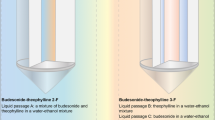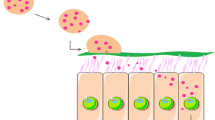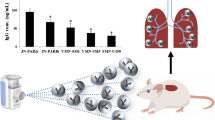Abstract
Purpose. This study describes the production of a budesonide nanosuspension by high-pressure homogenization for pulmonary delivery from 40 mL up to 300 mL. The aim was to obtain a nanosuspension that can be nebulized and is also long-term stable.
Methods. The nanosuspension was produced by high-pressure homogenization. Particle size analysis was performed by laser diffraction and photon correlation spectroscopy. For further particle characterization, zeta potential was determined. To investigate the aerosolization properties, the nanosuspension was nebulized and afterward analyzed on particle size.
Results. It was possible to obtain a long-term stable budesonide nanosuspension. Mean particle size of this nanosuspension was about 500-600nm, analyzed by photon correlation spectroscopy. Analysis by laser diffraction showed that the diameters 95% and 99% were below 3 μm. Budesonide nanosuspension showed a long-term stability; no aggregates and particle growth occurred over the examined period of 1 year. The PCS diameter before and after aerosolization did not change, and the LD diameters increased negligibly, showing the suitability for pulmonary delivery. The scale-up from 40 mL up to 300 mL was performed successfully.
Conclusions. High-pressure homogenization is a production method to obtain nanosuspensions with budesonide for pulmonary application.
Similar content being viewed by others
REFERENCES
The Merk Manual of Diagnosis and Therapy. 5th ed. MSD Sharp and Dohme GmbH (ed.), München, Germany, 1993.
List of Pharmaceutical Substances. 11th ed. ABDATA, Eschborn/ Taunus, Germany, 1998.
R.H. Müller, K. Peters, R. Becker, and B. Kruss. Nanosuspensions–a novel formulation for the i.v. administration of poorly soluble drugs. Proceed. 1st World Meeting of the APGI/APV Budapest, pp. 491-492 (1995).
C. Nyström. Dissolution properties of soluble drugs: theoretical background and possibilities to improve the dissolution behaviour. In: R. H. Müller, S. Benita, B. Böhm, eds. Emulsions and Nanosuspensions for the Formulation of Poorly Soluble Drugs. Stuttgart: Medpharm Scientific Publishers, 1998, pp. 143–147.
C. Nyström and S. Saers. Solid dispersions for fast release and dissolution of drug with low aqueous solubility in formulation of poorly-available drugs for oral administration. European Symposium Paris, 5-6 February APGI Swedish Academy of Pharmaceutical Sciences, pp. 94–103 (1996).
A. P. Simonelle, S. C. Metha, and W. I. Higuchi. Inhibition of sulfathiazole crystal growth by polyvinylpyrrolidone. J. Pharm. Sci. 56:633 (1970).
D. J. W. Grant and H. G. Brittain. Solubility of pharmaceutical solids. In: H. G. Brittain (ed.) Physical Characterization of Pharmaceutical Solids. Marcel Dekker, New York, 1995, pp. 321–386.
R. H. Müller and B. H. L. Böhm. Nanosuspensions. In: R. H. Müller, S. Benita, and B. H. L. Böhm (eds.). Emulsions and Nanosuspensions for the Formulation of Poorly Soluble Drugs. Medpharm Scientific Publishers, Stuttgart, 1998, pp. 149–174.
M. J. Grau and R. H. Müller. Increase of dissolution velocity and solubility of poorly soluble drugs by formulation as nanosuspension. Proceeding of the 2nd World Meeting of the APGI/APV Paris, pp. 623-624 (1998).
G. G. Liversidge and K. C. Cundy. Particle size reduction for improvement of oral bioavailability of hydrophobic drugs. I. Absolute oral bioavailability of nanocrystalline danazol in beagle dogs. Int. J. Pharm. 125:91–97 (1995).
R. H. Müller, C. Jacobs, and O. Kayser. Nanosuspensions as particulate drug formulations in therapy: rationale for development and what we can expect for the future. Adv. Drug Deliv. Rev 47:3–19 (2001).
R. H. Müller, R. Becker, B. Kruss, and K. Peters. Pharmaceutical nanosuspensions for medicament administration as systems with increased saturation solubility and rate of dissolution. United States Patent No. 5,858,410, 1999.
R. H. Müller, C. Jacobs, and O. Kayser. Nanosuspensions for the Formulation of Poorly Soluble Drugs In: F. Nielloud and G. Marti-Mestres (eds.). Pharmaceutical Emulsions and Suspensions. Marcel Dekker, New York, 2000, pp. 383–407.
A. J. Hickey. Pharmaceutical Inhalation Aerosol Technology. Marcel Dekker, New York, 1992.
G. Ponchel, M.-J. Montisci, A. Dembri, C. Durrer, D. Duchene. Mucoadhesion of colloidal particulate systems in the gastrointestinal tract. Eur. J. Pharm. Biopharm. 4:25–31 (1997).
P. Gaßmann, M. List, A. Schweitzer, and H. Sucker. Hydrosols-alternatives for the parenteral application of poorly water soluble drugs. Eur. J. Pharm. Biopharm. 40:64–72 (1994).
E. Merisko-Liversidge, P. Sarpotdar, J. Bruno, S. Haji, L. Wie, N. Peltier, J. Rake, J. M. Shaw, S. Pugh, L. Polin, J. Jones, T. Corbett, E. Cooper, and G. G. Liversidge. Formulation and antitumor activity evaluation of nanocrystalline suspensions of poorly soluble anticancer drugs. Pharm. Res. 13:272–278 (1996).
S. Jahnke. The theory of high-pressure homogenization. In: R. H. Müller, S. Benita, and B. H. L. Böhm (eds.). Emulsions and Nanosuspensions for the Formulation of Poorly Soluble Drugs. Medpharm Scientific Publishers, Stuttgart, 1998, pp 177–200.
R. H. Müller and K. Peters. Nanosuspensions for the formulation of poorly soluble drugs. I. Preparation by a size-reduction technique. Int. J. Pharm. 160:229–237 (1998).
T. S. Wiedmann, L. DeCastro, and R. W. Wood. Nebulization of nanocrystals: production of a respirable solid-in-liquid-in air colloidal dispersion. Pharm. Res. 14:112–116 (1997).
Die rote Liste. Edited by Association of the Pharmaceutical Industry e.V. Frankfurt a.M., Germany (1999).
P. Holzner. FCKW-freie aerosole und dispergiersysteme. In: R.H. Müller and G. E. Hildebrand (eds.). Pharmazeutische Technologie: Moderne Arzneiformen. 2nd ed. Wissenschaftliche Verlagsgesellschaft mbH, Stuttgart, 1998, pp. 59–66.
B. H. L Böhm, D. Behnke, and R. H. Müller. Production of paclitaxel nanosuspensions by high-pressure homogenization. Proceed. Intern. Symp. Control. Release Bioact. Mater. 24:927–928 (1997).
R. H. Müller, K. Peters, R. Becker, and B. Kruss. Nanosuspensions for the i.v. administration of poorly soluble drugs-stability during sterilization and long-term storage. Proc. Intern. Symp. Control. Release Bioact. Mater. 22:574–575 (1995).
R. H. Müller. Zetapotential und partikelladung?kurze theorie, praktische meßdurchführung, dateninterpretation. Wissenschaftliche Verlagsgesellschaft Stuttgart, 1996.
T. M. Riddick. Zeta-Meter Manual. Zeta-Meter Inc., New York, 1968.
Author information
Authors and Affiliations
Corresponding author
Rights and permissions
About this article
Cite this article
Jacobs, C., Müller, R.H. Production and Characterization of a Budesonide Nanosuspension for Pulmonary Administration. Pharm Res 19, 189–194 (2002). https://doi.org/10.1023/A:1014276917363
Issue Date:
DOI: https://doi.org/10.1023/A:1014276917363




